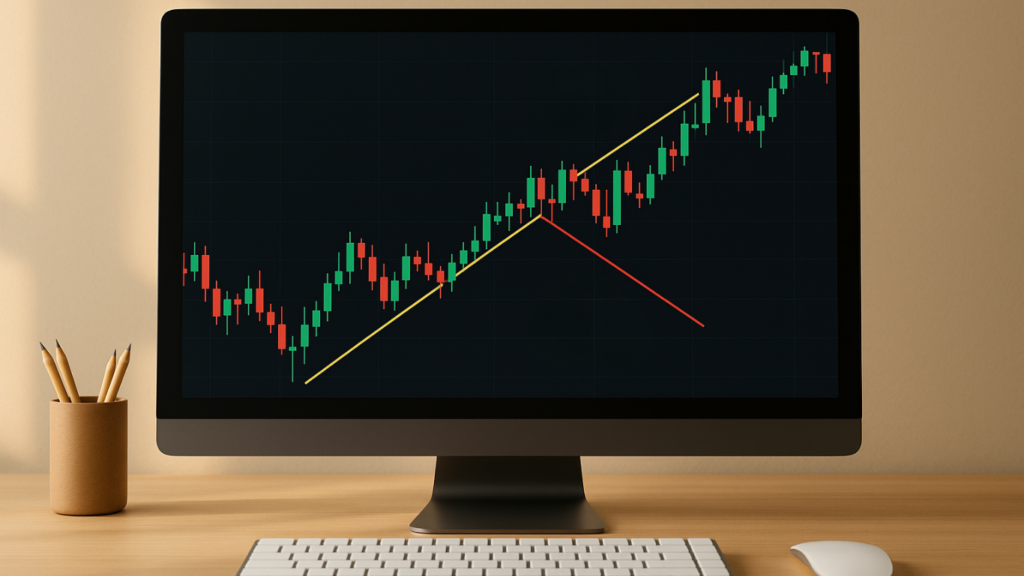Breakout trading (or breakout entry and exit) is a strategy where traders enter a position when an asset’s price moves beyond a key support or resistance level, often accompanied by higher volume. The goal is to profit from significant price movements in stocks, forex, or other assets. However, false breakouts can lead to losses, so traders use tools like volume analysis and technical indicators to confirm trends.
Key Takeaways:
- Timing is Critical: Enter too early, and you risk a false breakout. Enter too late, and you may miss the best part of the move.
- Systematic Approach: Stick to clear rules for what, when, and how much to trade to avoid emotional decisions.
- Risk Management: Never risk more than 1–2% of your capital per trade. For example, with SGD 10,000, limit risk to SGD 100–200 per trade.
- Exit Strategies: Use fixed targets, trailing stops, or dynamic exits based on market conditions to lock in profits or minimise losses.
- Tools Matter: Platforms like TradingView or MetaTrader, along with indicators like RSI and MACD, help identify breakout opportunities.
Tools and Preparation for Breakout Trading
To excel in breakout trading, having the right tools and preparation is key. These elements help reduce the chances of falling for false breakouts and set you up for success, especially when navigating Singapore’s trading environment.
Key Tools for Breakout Trading
Start with reliable charting software like TradingView or MetaTrader. These platforms allow you to pinpoint support and resistance levels and track real-time price movements effectively.
Incorporate technical indicators into your analysis. Tools such as moving averages, RSI, Bollinger Bands, and MACD can provide insights into trends, overbought or oversold conditions, and momentum shifts.
Volume analysis is another crucial component. Genuine breakouts are often accompanied by a surge in trading volume – typically 1.5 to 2 times the average daily volume. Volume confirmation acts as a safeguard, helping traders steer clear of false signals. Most charting platforms include built-in volume indicators that display this data alongside price charts.
For traders focusing on SGX-listed stocks, these tools are particularly useful. Observing volume spikes during Singapore trading hours can validate breakout patterns in local stocks, making it easier to act with confidence.
Once your tools are in place, the next step is to develop a disciplined trading plan.
Building a Trading Plan
A well-crafted trading plan takes the guesswork out of trading and promotes consistency. Start by defining clear entry and exit rules. For example, you might decide to enter a trade only when the price closes above resistance with a volume increase of at least 50% above the average. Exit criteria could include either a fixed 3:1 reward-to-risk ratio or a price drop back below the breakout level.
Risk management is another cornerstone of your plan. Determine how much of your account you’re willing to risk per trade – typically 1–2%. For instance, if your trading account holds SGD 10,000, you should limit your risk to SGD 100–200 per trade. Additionally, set daily loss limits to ensure you stop trading if losses exceed a certain threshold.
Trade selection criteria help you zero in on high-probability setups. These criteria might include minimum volume requirements, specific chart patterns, or even fundamental factors like earnings announcements or sector performance. Writing down these guidelines ensures you apply them consistently.
Finally, include a process for reviewing your trades. A trade journal can be incredibly helpful here. Record details such as entry and exit points, volume data, your reasoning behind the trade, and the outcome. Analysing this information can reveal patterns in your trading, allowing you to fine-tune your strategy over time.
This structured approach prepares you to navigate the complexities of Singapore’s trading environment more effectively.
Singapore Trading Considerations
To succeed in Singapore’s market, align your tools and trading plan with local nuances. Always calculate position sizes and stop-loss distances in Singapore dollars to ensure your risk management aligns with your financial goals. This keeps your exposure consistent and easy to manage.
For trade logs, use the DD/MM/YYYY date format to maintain clear and compliant records. This standardisation not only keeps your records organised but also ensures adherence to local financial regulations.
Timing is another critical factor. Familiarise yourself with SGX trading hours and consider how regional markets might influence local breakout opportunities. For example, Singapore’s high trade-to-GDP ratio – often exceeding 300% – means that global trade developments can have a significant impact on local stocks. Recognising these connections can help you anticipate and act on potential breakouts.
Example: Suppose you’re trading a Singapore-listed stock priced at SGD 2.00, with resistance at SGD 2.10. You could set alerts for volume spikes and monitor for a breakout above SGD 2.10 on twice the 20-day average volume. If the price reaches SGD 2.12, you might enter the trade with a stop-loss at SGD 2.05, risking 1% of your SGD 10,000 account (or SGD 100). Your target could be SGD 2.25, based on the height of the previous consolidation range.
For those looking to deepen their skills, the Collin Seow Trading Academy offers courses and free resources tailored to Singapore traders.
Breakout Entry Methods
Timing your entry is key to succeeding with breakout trades. The approach you choose should align with your risk appetite, market conditions, and trading style. For traders in Singapore, strategies often take into account local market liquidity and unique trading patterns.
Immediate Entry vs Confirmation Entry
Immediate entry involves jumping into a trade as soon as the price moves past a key level. For example, if a stock breaks above a resistance level at S$10.00, you might enter at S$10.01 to catch the early momentum. This method can maximise potential gains if the breakout is strong, but it comes with higher risk, especially during volatile market conditions when false signals are more common.
On the other hand, confirmation entry requires waiting for additional signs that the breakout is reliable – such as a candle closing above the resistance level. Using the same example, you might wait and enter at S$10.10. While this approach reduces the risk of falling for a false breakout, it often means entering at a less favourable price.
Here’s a quick comparison of the two methods:
| Entry Method | Entry Price Example | Risk | Potential Profit | Best For |
|---|---|---|---|---|
| Immediate | S$10.01 | Higher | Maximum | Fast-moving markets |
| Confirmation | S$10.10 | Lower | Good | Volatile conditions |
Many seasoned traders in Singapore combine these strategies. They might use immediate entry when they see strong volume confirmation and opt for confirmation entry in less certain scenarios, such as during major news events or in choppy markets.
Volume plays a critical role in validating these breakout strategies.
Using Volume to Confirm Breakouts
Volume spikes – typically 20–30% above the recent average – are a reliable way to confirm breakouts. In Singapore’s market, where institutional trading often drives trends, this becomes even more important. For instance, if a stock’s usual volume is around 80,000 shares, a breakout accompanied by a jump to 150,000 shares signals stronger buying interest. Conversely, breakouts on weak volume should be approached with caution.
To make this easier, configure your trading charts to display both price and volume. When you spot a potential breakout, check if the volume is increasing alongside the price move. A flat or declining volume during a breakout might indicate a lack of genuine market interest.
While volume confirmation is crucial, refining your timing further with session dynamics can enhance your strategy.
Opening Range Breakout Strategy
The Opening Range Breakout (ORB) strategy focuses on the first 15–30 minutes of trading to define a stock’s range. For example, if a stock trades between S$9.90 and S$10.10 during the initial 15 minutes after the SGX opens at 9:00 AM, a breakout above S$10.10 on high volume could signal a long entry. Conversely, a drop below S$9.90 might indicate a shorting opportunity.
This approach assumes that the opening range reflects the market’s initial consensus on fair value. A breakout beyond this range suggests new information or sentiment is pushing prices. ORB works particularly well after significant overnight news or economic data that impacts the market at the open.
Risk management is vital with ORB. Place your stop-loss just beyond the opposite end of the opening range. For instance, if you go long at S$10.11 after a breakout above S$10.10, a logical stop-loss could be set just below the range’s low, around S$9.89. Be cautious of common pitfalls, such as false breakouts during low-volume periods, and ensure you can execute trades quickly to avoid missing opportunities.
Master Systematic Trading with Collin Seow
Learn proven trading strategies, improve your market timing, and achieve financial success with our expert-led courses and resources.
sbb-itb-466c9b0
Breakout Exit Methods
How you exit a breakout trade can make all the difference between locking in modest gains or riding the wave to significant profits. It can also be the line between a minor loss and a more substantial setback. Professional traders often rely on three main strategies for exiting breakouts: fixed targets, trailing stops, and dynamic exits based on market conditions. These methods complement the entry strategies we’ve discussed, creating a well-rounded breakout trading plan.
Fixed Target Exits
Fixed target exits help traders stick to a systematic plan for taking profits. A common method involves setting a profit target based on a multiple of your stop-loss distance. For instance, if you enter a breakout trade on Singapore Airlines at S$6.50 with a stop loss at S$6.30, your risk per share is S$0.20. Using a 1.5:1 reward-to-risk ratio, your target would be S$6.80.
Another approach is the measured move technique, which calculates the height of the consolidation pattern and projects it in the direction of the breakout. For example, if a stock consolidates between S$8.00 and S$8.40 before breaking out, the S$0.40 range is added to the breakout point. A breakout at S$8.45 would then target S$8.85.
Many traders in Singapore aim for reward-to-risk ratios of at least 2:1, meaning the potential profit is twice the amount risked. This ensures profitability even with a win rate around 50%. However, fixed targets can sometimes limit earnings during strong trends where prices exceed the initial projection. Despite this, their predictability makes them a reliable tool for position sizing and managing risk.
Trailing Stop Loss for Extended Profits
Trailing stops are a great alternative when fixed targets might cut gains short. They allow traders to follow a trend and lock in profits as the price moves in their favour. Studies suggest trailing stops can improve average trade returns by up to 30% in trending markets. However, they may not perform as well in choppy conditions, where price pullbacks can trigger early exits.
Here’s an example: You buy CapitaLand Investment at S$3.20 after a breakout, with an initial stop at S$3.00. As the price rises to S$3.40, you move your stop to S$3.20, ensuring no loss. When the price climbs to S$3.60, your stop adjusts to S$3.40, and so on. For mid-cap Singapore stocks, a trailing distance of S$0.20 to S$0.30 generally accounts for typical price swings. Some traders prefer percentage-based trailing stops, such as setting the stop 2–3% below the highest price reached.
While trailing stops can capture larger profits in trending markets, they come with a trade-off. Some trades might reverse and hit the trailing stop, reducing the final gain. Still, they remain a valuable tool for maximising returns in favourable conditions.
Dynamic Exits Using Market Events
Dynamic exits rely on real-time market developments rather than predetermined price levels. This method requires active monitoring but can be highly effective for protecting profits when market conditions shift unexpectedly. In fact, over 60% of active traders incorporate dynamic exits alongside technical targets.
For example, news-driven exits are crucial during earnings announcements, Monetary Authority of Singapore (MAS) policy updates, or major geopolitical events. If you’re holding a breakout position in a banking stock and MAS announces unexpected regulatory changes, exiting immediately might help you lock in gains.
Another signal for a dynamic exit is declining volume. If breakout momentum fades – evidenced by a drop in volume even as prices rise – it could indicate that the trend is losing steam. Broader market sentiment can also serve as a cue; significant declines in the Straits Times Index might suggest unfavourable conditions ahead.
The biggest challenge with dynamic exits is separating meaningful changes from short-term noise. Exiting too early can cut profits short, while waiting too long might cost you gains. This method works best for traders who can dedicate time to actively monitor and interpret market signals.
Combining Exit Strategies
A hybrid approach – using fixed targets for part of your position and trailing stops for the rest – provides a balance between discipline and flexibility. This strategy aligns with the risk management principles discussed earlier, ensuring consistency in your trading plan.
If you’re looking to refine your exit strategies, resources like Collin Seow Trading Academy offer webinars and tools to help you integrate market events into your decisions. These structured approaches can help you avoid common mistakes and improve your overall trading performance.
Risk Management and Trade Review
Breakout trading thrives on two pillars: protecting your capital and learning from every trade. Without these, even the most promising breakout strategy can lead to financial setbacks. What often separates successful traders from those who struggle is how well they manage risk and evaluate their trades.
Position Sizing and Risk Management in SGD
Effective risk management starts with deciding how much of your capital to allocate to each trade. This is especially important in breakout trading, where price movements can be rapid and unpredictable.
A good rule of thumb is to risk no more than 1–2% of your trading capital on a single trade. For traders in Singapore, it’s crucial to perform these calculations in SGD to avoid errors from currency conversions. For instance, if you have a trading account with SGD 50,000 and decide to risk 1% (SGD 500) per trade, buying DBS shares at SGD 35.00 with a stop-loss set at SGD 33.50 would limit your risk per share to SGD 1.50. This means your position size would be about 333 shares.
It’s also wise to adjust your position size based on market conditions and the strength of the breakout. For example, during volatile periods or when trading less liquid SGX stocks, reducing your position size can help manage risks arising from wider spreads and market uncertainty. Tailoring your approach to the SGX’s unique liquidity and volatility ensures your strategy remains practical and effective. Once your position sizing and stop-loss levels are set, the next step is to track and review each trade.
Tracking and Reviewing Breakout Trades
Strict risk management is only part of the equation; tracking your trades is equally important for long-term improvement. Research shows that traders who consistently document and review their trades tend to perform better over time. A trading journal is an essential tool for this. Record key details such as entry and exit prices (in SGD), position sizes, stop-loss levels, target prices, the reasoning behind the trade, and the final outcome.
Pay special attention to your losing trades – they often reveal weaknesses in your strategy that winning trades might not. Focus on metrics like your win rate, average reward-to-risk ratio, and maximum drawdown. A commonly recommended reward-to-risk ratio is at least 2:1. For example, if your average winning trade earns you SGD 800 and your average losing trade costs you SGD 300, your reward-to-risk ratio stands at approximately 2.67:1. Regularly reviewing these metrics helps you spot patterns and refine your trading strategy.
Learning and Education Resources
Breakout trading isn’t static – it evolves with market conditions. Staying informed and continually learning is crucial to adapting your risk management strategies. For Singapore traders, this includes keeping an eye on SGX trading hours, updates from the Monetary Authority of Singapore, and liquidity in the local market.
Educational resources like Collin Seow Trading Academy’s free e-courses, live webinars, and The Systematic Trader v.2 can be invaluable. These tools provide insights into refining your risk management and trade review processes, reinforcing the systematic trading strategies outlined in this guide.
Conclusion
Achieving success in breakout trading hinges on a structured approach, disciplined risk management, and impeccable timing. These elements work together to transform breakout opportunities into consistent profits.
As Collin Seow highlights, making informed decisions through a systematic methodology is key. This involves addressing the three essential questions every trader must consider: what to buy, when to buy, and how much to buy. In breakout scenarios, where prices can move rapidly, having a clear and strategic plan is non-negotiable.
One of the most dependable tools for traders is volume confirmation, which helps verify the authenticity of breakouts and minimises the risk of falling prey to false signals. Pairing this with well-timed entries – whether immediate or after confirmation – enhances the likelihood of capturing meaningful price moves while steering clear of fakeouts. These techniques are especially relevant for navigating the intricacies of the Singapore market.
For traders dealing with SGX-listed stocks or managing positions in SGD, applying such principles is crucial. A systematic approach ensures consistency, even in fluctuating market conditions, while maintaining a reward-to-risk ratio of at least 2:1. This disciplined framework provides a solid foundation for long-term success.
Ultimately, a disciplined, informed, and strategic mindset is the cornerstone of profitable trading. Regular trade reviews, proper position sizing, and continuous learning – such as through resources from the Collin Seow Trading Academy – are essential practices that reinforce this mindset.
Breakout trading success isn’t about luck; it’s about executing a well-tested system with patience and precision. By applying these strategies and risk management principles, you can approach breakout opportunities with confidence and consistency, paving the way for steady growth in your trading journey.
FAQs
How can I identify a genuine breakout versus a false breakout in the Singapore market?
To tell the difference between a real breakout and a false one in the Singapore market, keep an eye on volume, price action, and the overall market conditions. A real breakout often comes with high trading volume, showing strong interest from traders. On the other hand, a false breakout usually lacks this level of activity.
You should also pay attention to how the price behaves after crossing a key support or resistance level. Real breakouts generally maintain their momentum in the direction of the move, while false breakouts tend to reverse quickly. Indicators like moving averages or the RSI can provide additional confirmation about the breakout’s validity.
If you’re looking for a more structured way to trade breakouts, platforms like Collin Seow Trading Academy offer resources designed to help traders sharpen their strategies and make better decisions.
What are some effective risk management strategies for trading breakouts on SGX-listed stocks?
Managing risk when trading breakouts on SGX-listed stocks is essential for building long-term success. One of the first steps you can take is setting a stop-loss order. This acts as a safety net, limiting your potential losses if the breakout doesn’t go as planned. To determine the right stop-loss level, look at key support or resistance points and ensure it fits within your personal risk tolerance.
Another smart move is practising position sizing. Instead of risking a large chunk of your capital, consider allocating just a small percentage – say 1-2% – to each trade. This way, even if a trade doesn’t work out, the impact on your overall portfolio is minimal. It’s a disciplined way to stay in the game while still taking advantage of opportunities.
Lastly, keep a close eye on volume and price action. A breakout supported by strong trading volume is usually more dependable, while weak volume could signal a false breakout. By combining these strategies, you can approach breakout trading with more confidence and better manage potential risks.
Why is volume confirmation important in breakout trading, and what key indicators should traders monitor?
Volume confirmation plays a key role in breakout trading as it helps determine the strength and reliability of a price breakout. When a breakout occurs alongside high trading volume, it often signals strong market interest and a better chance of a sustained price movement. This can significantly lower the chances of falling for false breakouts.
Here are some important volume indicators to watch:
- Volume spikes: A noticeable surge in volume during the breakout can indicate robust market activity.
- Volume patterns: A steady rise in volume leading up to the breakout often points to growing momentum.
- Volume compared to average: Checking current volume against the average daily volume helps gauge its significance.
By factoring volume analysis into your trading strategy, you can make better-informed decisions and increase your likelihood of achieving favourable outcomes in the market.












